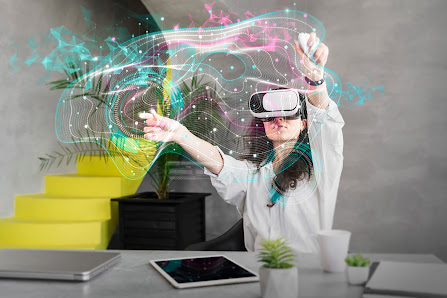Embracing the Metaverse: Revolutionizing Education in the Digital Realm
In the ever-evolving landscape of technology, the concept of the metaverse has emerged as a groundbreaking frontier, promising to reshape the way we interact, learn, and connect with the world around us. As virtual environments continue to gain traction, educators are exploring innovative ways to harness the power of the metaverse to revolutionize the field of education. In this article, we delve into the potential of the metaverse in education, exploring its benefits, challenges, and the transformative impact it can have on teaching and learning.
Understanding the Metaverse:
Before delving into its application in education, let's first understand what the metaverse entails. The metaverse refers to a collective virtual space that encompasses a vast, interconnected network of immersive digital environments. In these virtual realms, users can interact with each other and with digital objects in real-time, blurring the lines between the physical and digital worlds.
The metaverse is not a single platform but rather a constellation of virtual spaces, ranging from virtual reality (VR) simulations and augmented reality (AR) experiences to social media platforms and online gaming environments. These digital spaces offer unprecedented opportunities for creativity, collaboration, and exploration, making them an ideal playground for educational innovation.
As educators explore the potential of the metaverse in reshaping traditional teaching methods, considerations for equitable access and inclusive practices come to the forefront. Additionally, if time constraints become a challenge, seeking assistance like "do my online class for me" can alleviate some of the pressure, allowing educators to focus on integrating immersive technologies into their curriculum effectively. Let's delve deeper into the benefits and challenges of leveraging the metaverse in education.
Benefits of the Metaverse in Education:
The integration of the metaverse into education holds immense potential for transforming traditional teaching and learning paradigms. Here are some key benefits:
Immersive Learning Experiences:
Virtual environments in the metaverse provide students with immersive learning experiences that transcend the limitations of traditional classrooms. Through VR simulations, students can explore historical landmarks, dissect virtual organisms, or even conduct experiments in simulated laboratories, enhancing their understanding of complex concepts through hands-on experiences.
Personalized Learning:
The metaverse allows for personalized learning experiences tailored to individual student needs and preferences. Educators can leverage data analytics and AI algorithms to track student progress, identify learning gaps, and deliver customized content and assessments, ensuring that each student receives targeted support to reach their full potential.
Global Collaboration:
One of the most powerful aspects of the metaverse is its ability to connect learners from around the globe in a shared virtual space. Through collaborative platforms and social VR environments, students can collaborate on projects, participate in virtual debates, and engage in cross-cultural exchanges, fostering a sense of global citizenship and cultural awareness.
Accessible Education:
The metaverse has the potential to democratize access to education by removing geographical barriers and providing opportunities for remote and underserved communities. With just a computer and internet connection, students can access high-quality educational resources and participate in virtual classrooms, regardless of their physical location.
Experiential Learning:
Virtual environments offer unparalleled opportunities for experiential learning, allowing students to engage with content in dynamic and interactive ways. Whether exploring the depths of the ocean, touring ancient civilizations, or conducting virtual field trips to far-flung destinations, students can develop a deeper understanding of subject matter through firsthand experiences.
Challenges and Considerations:
While the metaverse holds great promise for education, its widespread adoption is not without challenges. Here are some key considerations:
Technical Barriers:
Access to immersive technology such as VR headsets and high-speed internet can be a barrier for some students, particularly those from low-income or rural communities. Ensuring equitable access to these technologies will be crucial in bridging the digital divide and ensuring that all students can benefit from the opportunities afforded by the metaverse.
Privacy and Safety Concerns:
As with any online environment, ensuring the privacy and safety of students in the metaverse is paramount. Educators must implement robust security measures and guidelines to protect students from potential risks such as cyberbullying, harassment, and inappropriate content.
Digital Literacy:
Navigating virtual environments requires a certain level of digital literacy and technical proficiency. Educators must provide training and support to help students develop the skills necessary to thrive in the metaverse, including critical thinking, information literacy, and digital citizenship.
Pedagogical Integration:
Effectively integrating the metaverse into educational practices requires thoughtful pedagogical design and curriculum development. Educators must carefully consider how to leverage virtual environments to enhance learning outcomes and engage students in meaningful ways, rather than simply replicating traditional teaching methods in a digital format.
Ethical Considerations:
The metaverse raises complex ethical questions related to data privacy, intellectual property rights, and digital ethics. Educators, policymakers, and industry stakeholders must work together to establish ethical guidelines and best practices for the responsible use of immersive technologies in education.
Future Outlook:
Despite the challenges, the future of education in the metaverse looks bright. As technology continues to evolve and virtual environments become increasingly sophisticated, the possibilities for educational innovation are virtually limitless. By embracing the metaverse as a transformative tool for teaching and learning, educators can empower students to explore, create, and collaborate in ways that were once unimaginable, paving the way for a more inclusive, equitable, and immersive educational experience for all.




Comments
Post a Comment